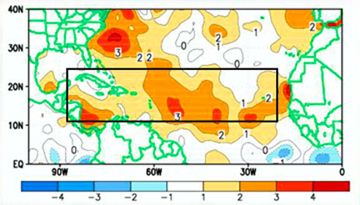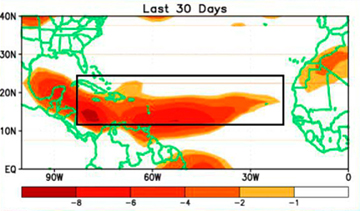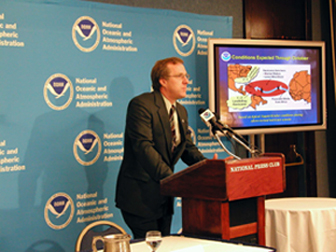Geotimes

Untitled Document

Web Extra
Monday, August 8, 2005
Hurricane outlook updated
 The first few months
of the 2005 hurricane season, which began June 1, took off with a vengeance.
Already, eight significant storms have formed over the Atlantic, from which
two grew into major hurricanes that included Emily — the strongest July
hurricane on record.
The first few months
of the 2005 hurricane season, which began June 1, took off with a vengeance.
Already, eight significant storms have formed over the Atlantic, from which
two grew into major hurricanes that included Emily — the strongest July
hurricane on record.
Hurricane Emily reached
Category 4 intensity (sustained winds up to 155 miles per hour) July 17, just
southwest of Jamaica. The record-breaking fifth named storm by mid-July signaled
a fast beginning to the 2005 Atlantic hurricane season. Emily was downgraded
to a tropical storm by the time it reached southern Texas. Image is courtesy
of NASA.
Such high activity early in the season, in addition to ripe oceanic and atmospheric
conditions, led the National Oceanic and Atmospheric Administration (NOAA) to
revise its hurricane outlook. Released Aug. 2, NOAA's new outlook indicates
an increase in the number of expected hurricanes. And they say that the majority
are yet to come.
"Typically June and July are quiet months," says Chris Vaccaro of
the NOAA National Weather Service. Hurricane activity usually culminates in
late August and goes into early October. "But this season, we have seen
a record number of storms form," he says. "We haven't even entered
the peak of the hurricane season yet."
The NOAA outlook projects a number of overall storms, hurricanes and major
hurricanes throughout the entire Atlantic basin, which includes the Atlantic
Ocean, the Gulf of Mexico and the Caribbean Sea. NOAA produces two outlooks:
The first is released in May prior to the onset of hurricane season, followed
by an update in August just before the season peaks. And when hurricane season
draws to a close at the end of November, NOAA recaps the predictions and the
final outcome of the season.
This year, the May outlook correctly predicted an above-average season that
called for between 12 to 15 tropical storms, with seven to nine becoming hurricanes,
and three to five of these becoming major hurricanes. The updated outlook, however,
upped the numbers for the total season to between 18 to 21 tropical storms,
with nine to 11 becoming hurricanes, and five to seven of these becoming major
hurricanes.
 |
 |
Multiple factors led to the increased number of storms. First, hurricanes need
warm water temperatures to strengthen and sustain them, Vaccaro says. And this
year, Atlantic water temperatures have ranged anywhere from 2 to 4 degrees Fahrenheit
warmer than average. Second, the wind in the upper levels of the atmosphere
that blow in the direction countering the storms' movement, known as wind shear,
has been lighter than normal. "So, when these storms have been forming,
they haven't encountered much resistance," Vaccaro says. "And therefore
they have been able to increase in intensity." Finally, easterly winds
from Africa must be in place in order to bring tropical disturbances west.
The chart (top) measures the degrees
above or below the normal sea-surface temperature for the month of July. Temperatures
were well above normal, especially within the main hurricane development region
depicted by the black box. Red shading on the chart (bottom) shows lower than
average vertical wind shear within the same region. Images are courtesy of NOAA.
Such favorable hurricane conditions, however, did not come as a surprise to
researchers. "They don't randomly come together," says Gerry Bell,
the lead meteorologist at NOAA, nor are they the result of global warming. Instead,
the conditions exist together as part of a cycle called the tropics-wide multi-decadal
signal. Although its cause is not known, the 20- to 30-year cycle has been observed
since the 1800s to control both water temperature and wind patterns and is "by
far the dominant climate pattern," Bell says. "Overall, those conditions
all occur together." 
Gerry Bell, lead meteorologist on NOAA's
Atlantic Hurricane Seasonal Outlook, announced Aug. 2 a revised hurricane outlook
at a Washington, D.C., news conference. The revised outlook calls for an increased
number of hurricanes. Image is courtesy of NOAA.
Another potential influence to the severity of hurricane seasons can be the
El Niño Southern Oscillation (ENSO), with La Niña conditions favoring
hurricanes and El Niño conditions discouraging them. According to NOAA,
however, ENSO events were neutral this year and will not affect the hurricane
season. But as the peak of the multi-decadal cycle approaches, NOAA expects
conditions to be sufficient for a large number of storms.
Still, of the predicted 18 to 21 total storms, not all make landfall, Vaccaro
says. "But it's reasonable to say that an additional two to three could
very well hit the United States based on what we've seen in past hurricane seasons
similar to this one." Everyone from southern Texas to Maine should be prepared
for hurricanes this season, Vaccaro says. "Hurricanes do not discriminate.
They will end wherever the atmospheric patterns lead them."
Kathryn Hansen
Links:
National
Hurricane Center Tropical Prediction Center
2005
hurricane season outlook
NOAA
hurricanes page
Back to top
Untitled Document

 The first few months
of the 2005 hurricane season, which began June 1, took off with a vengeance.
Already, eight significant storms have formed over the Atlantic, from which
two grew into major hurricanes that included Emily — the strongest July
hurricane on record.
The first few months
of the 2005 hurricane season, which began June 1, took off with a vengeance.
Already, eight significant storms have formed over the Atlantic, from which
two grew into major hurricanes that included Emily — the strongest July
hurricane on record. 



